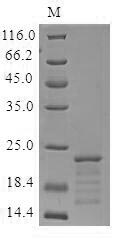The region for expressing recombinant Mouse Mb (Myoglobin) contains amino acids 2-154. This Mb (Myoglobin) protein is theoretically predicted to have a molecular weight of 21.9 kDa. This Mb (Myoglobin) recombinant protein is manufactured in mammalian cell. The N-terminal 10xHis tag and C-terminal Myc tag was fused into the coding gene segment of Mb (Myoglobin), making it easier to detect and purify the Mb (Myoglobin) recombinant protein in the later stages of expression and purification.
Mouse myoglobin (Mb) is a globular protein encoded by the Mb gene. Like its human counterpart, mouse myoglobin is primarily expressed in muscle tissues, where it plays a crucial role in oxygen storage and transport. Myoglobin is a heme-containing protein, with a single heme group per molecule that binds oxygen, allowing for its storage and release within muscle cells. This facilitates efficient oxygen supply to working muscles during periods of increased activity. Myoglobin is an essential component of the oxygen homeostasis machinery in muscle tissues. Research on mouse myoglobin helps to understand its role in oxygen metabolism, muscle function, and its implications in various physiological processes.






